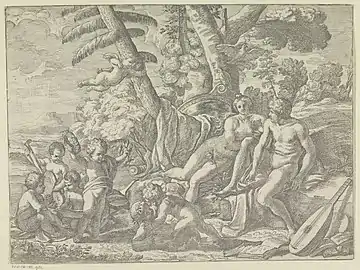Fabrizio Chiari
Fabrizio Chiari (c.1615–1695[1][2][n 1]) was an Italian painter and engraver who spent his entire life in Rome.[1]
 |
|
| Original by Nicolas Poussin | Etching by Fabrizio Chiari |
Chiari's early etchings from Nicolas Poussin paintings are described by Michael Bryan as "executed in a scratchy but masterly style";[4] among them are:[1][4]
- Mars and Venus, in a landscape, signed "Fabritius Clarus" 1635.
- Venus and Mercury with Children, signed "Chlarus" 1636
- Venus and Adonis, signed "Nicolaus Pussinus"; This etching has been erroneously attributed to Poussin.
Chiari was enrolled in the Accademia di San Luca from 1635.[1] In San Martino ai Monti in the 1640s he painted the altarpiece, St Martin Dividing his Cloak with the Beggar, and a fresco, The Baptism of Christ, which was overpainted in the 18th century by Antonio Cavallucci.[5] To mark the 1658 canonization of Thomas of Villanova, he painted St. Thomas of Villanova Distributing Alms for Santa Maria del Popolo.[6] His Assumption of the Virgin and Death of St Anne, commissioned in 1654 for the chapel of Regina Coeli convent, were misplaced when it became a prison in 1880;[1][7] the latter turned up in 2012 and in 2019 sold for $30,000 at Sotheby's.[1][8] Others of Chiari's works are no longer known, including church paintings mentioned by Filippo Titi and drawings listed by Nicola Pio.[1] In 1675 Chiari decorated the Sala degli Specchi in the Palazzo Altieri, including a ceiling fresco, The Chariot of Apollo,[9][n 2] in which the cornices, unusually, depict the four ages of man rather than the four seasons.[10]
Footnotes
- Pellegrino Antonio Orlandi gives 1621 as his birth year.[3]
- Not to be confused with the ceiling fresco of the same name in the Palazzo Barberini by Giuseppe Bartolomeo Chiari.[9]
References
- Fattorosi Barnaba, Nicoletta (1980). "CHIARI, Fabrizio". Dizionario Biografico degli Italiani (in Italian). Vol. 24.
- "Fabrizio Chiari (c. 1615-95) - An allegory in honour of Ferdinand, King of Hungary". Royal Collection Trust. Retrieved 12 March 2021.; Mossakowski, Stanisław (2009). "Gli anni romani di Giovanni Battista Gisleni". Biuletyn Historii Sztuki. 71 (1–2): 40. doi:10.11588/artdok.00004346.
- Orlandi, Pellegrino Antonio; Guarienti, Pietro (1763). Abecedario Pittorico (in Italian) (corrected and enlarged ed.). Naples. p. 143.
- Bryan, Michael (1816). "Chiari, Fabrizzio". A Biographical and Critical Dictionary of Painters and Engravers. Vol. 1. London: Carpenter. p. 272.
- Sutherland, Ann B. (1964). "The Decoration of San Martino ai Monti — I". The Burlington Magazine. 106 (731): 62, 69. ISSN 0007-6287. JSTOR 874182.
- Colantuoni, Raffaele (1899). La chiesa di S. Maria del Popolo negli otto secoli dalla prima sua fondazione, 1099-1899: storia e arte (in Italian). RomE: Desclée, Lefebvre. p. 115.
- "Lot 165: Fabrizio Chiari The Death of St Anne". Important Old Master Paintings and Sculpture. Sotheby's. 2012. Retrieved 12 March 2021.
- "Fabrizio Chiari The Death of St Anne". LotSearch. Retrieved 12 March 2021.
- De Iulis, Enrico (2019). "La via dell'ambrosia : lettura iconologica dell'affresco di Guido Reni nel Casino Rospigliosi Pallavicini". Ricche Minere. 6 (11): 53 (fig 5), 55 (fig 8), 56. Retrieved 12 March 2021.
- Montagu, Jennifer (1978). "Bellori, Maratti and the Palazzo Altieri". Journal of the Warburg and Courtauld Institutes. 41: 337 fn.12. doi:10.2307/750881. ISSN 0075-4390. JSTOR 750881.
Further reading
- Strinati, Claudio (2019). "Su Fabrizio Chiari". In Baldassarri, Francesca; Confalone, Maia (eds.). Gli amici per Nicola Spinosa (in Italian). Rome: Ugo Bozzi. pp. 110–115. ISBN 978-88-7003-061-7.
